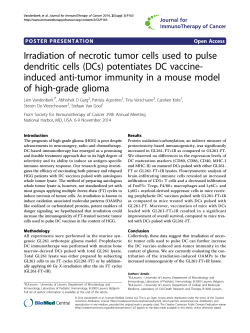
MOJ Immunology
MOJ Immunology Cancer Immunotherapy: How to Optimize Immunotherapy It took four decades of research before scientists and clinicians pay serious attention to immunotherapy as an alternative procedure to chemotherapy and/or radiotherapy for cancer patients. While many scientists trying to develop certain so called therapeutic vaccine for cancer treatment, these vaccines might be effective for non-solid tumors like lymphoma and leukemia; whereas treatment of solid tumors definitely require surgery followed by either chemotherapy or radiotherapy in order to wipe off any remaining tumor cells might have been left at the site of surgery. These cells are main cause of tumor recurrence and metastasis. Chemotherapy and radiotherapy both are effective for killing tumor cells but they also kill normal cells including immunocytes; hence, weakening immune response which sometimes cause expedite morbidity and mortality of the patient. Immunotherapy in the other hand, potentiate immune response in order to kill tumor cells effectively and is safe for normal cells meaning none or minimal side effects. Thus far, various immunotherapy procedures have been developed and applied as an alternative to chemotherapy for either treatment of metastatic tumors or following surgery of a primary tumor. The more promising procedures are: activated of CD8+ T cells therapy [1] and antigen pulsed dendritic cells therapy [2]. Both types have shown to have beneficial effect for protecting patient but still no gold standard procedure has been developed that work for all type cancers. Dendritic cells (DC) therapy mostly has been used to potentiate immune response in order to treat cancer patient nonspecifically but if these cells pulsed with tumor specific antigen, would be able to expand and activate cytotoxic T cell cells (CTL) and eliminate tumor cells [3]. This means specific immunotherapy requires activation of CD8+ T cells by either direct activation using various cytokines [4], or by mature antigen pulsed DCs [5] or by an immunomodulator that can activate these cells such as IL-2. However, activation of CD8+ T cells to act as tumor specific cytotoxic cells is very complex task involving various signals, and cooperation of various immunocytes [6]. In a paper published in June 2014 issue of the MOJ Immunology, Barber [7] argued about complexity of stimulation of CD8+ Tcells involving various T cell receptors and co-stimulatory factors. The author concludes we need to know which receptor is responsible for optimization of immunotherapy. Co-stimulation of CD8+ T cells is mediated by CD80 [8], CD70, TNFRSF9 [9] and DC derived cytokines such as IL-12 and IL-15 [10]. Expansion of CD8+ T cells is regulated by CD4+ T cells [11]; however, certain CD4+ T cells that express CD25 in their surface (Treg) can inhibit generation of CD8+ cytotoxic T cells by secreting IL-4 [12]. Thus, in my opinion, optimization of immunotherapy by CD8+ T cells requires elimination of CD25+ Treg cells in addition to stimulation of the cytotoxic CD8+ T cells. In our recent preliminary study (un-published data), we applied anti-CD25 antibody in Submit Manuscript | http://medcraveonline.com Editorial Volume 1 Issue 3 - 2014 Nemat Khansari* NK-Immunotherapy Laboratory, USA *Corresponding author: Nemat Khansari, NK- Immunotherapy Laboratory, 17 Matisse Cir #8, Aliso Viejo, CA 92656, USA, Tel: 949-228-8290; Fax: 949-2200278; Email: nkhansari928@gmail.com Received: July 17, 2014 | Published: July 18, 2014 the site of surgically removed tumor in order to prevent tumor recurrence and applied general immunotherapy using DC pulsed autologous tumor antigen. Results showed remarkable prevention of tumor recurrence in compare to control groups. We think this procedure is best alternative therapy to chemotherapy or radiotherapy following surgically removal of tumor. References 1. Zang N, Bevan MJ (2011) CD8+ T cells: foot soldiers of the immune system. Immunity 35(2): 161-168. 2. Palucka K, Banchereau J (2012) Cancer immunotherapy via dendritic cells. Nat Rev Cancer 12(4): 265-277. 3. Fuertes MB, Kacha AK, Kline J, Woo SR, Kranz DM, et al. (2011) Host type I INF signals are required for antitumor CD8+ T cell responses through CD8α+ dendritic cells. J Exp Med 208(10): 2005-2016. 4. Curtsinger JM, Lins DC, Mescher MF (2003) Signal 3 determines tolerance versus full activation of naïve CD8 T cells: dissociating proliferation and development of effector function. J Exp Med 197(9): 1141-1151. 5. Palucka K, Banchereau J (2002) How dendritic cells and microbes interact to elicit or subvert protective immune responses. Cur Opin Immunol 14(4): 420-431. 6. Mescher MF, Curtsinger JM, Agarwal P, Casey KA, Gerner M, et al. (2006) Signals required for programming effector and memory development by DC8+ T cells. Immunol Rev 211: 81-92. 7. Barber A (2014) Costimulation of effector CD8+ T cells: Which receptor is optimal for immunotherapy. MOJ Immunol 1(2): 00011. 8. Chen L, Ashe S, Brady WA, Hellstrom I, Hellestrom KE, et al. (1992) Costimulation of antitumor immunity by the B7 counterreceptor for the T lymphocyte molecules CD28 and CTLA-4. Cell 71(7): 1093-1102. 9. Shuford WW, Klusman K, Tritchen DD, Loo DT, Chalupny J, et al. (1997) 4-1BB costimulatort signals preferentially induce CD8+ T cell proliferation and lead to the amplification in vivo of the cytotoxic T cells responses. J Exp Med 186(1): 47-55. 10.Waldmann TA (2006) The biology of interleukin-2 and interleukin-15: implications for cancer therapy and vaccine design. Nat Rev Immunol 6(8): 595-601. MOJ Immunol 2014, 1(3): 00015 Cancer Immunotherapy: How to Optimize Immunotherapy 11.Pardoll DM, Topalian SL (1998) The role of CD4+ T cell responses in antitumor immunity. Curr Opin Immunol 10(5): 588-594. Copyright: 2014 Khansari 2/2 12.Sasaki K, Pardee AD, Okada H, Stokus WJ (2008) IL-4 inhibits VLA4 expression on Tc1 cells resulting in poor tumor infiltration and reduced therapy benefit. Eur J Immunol 38(10): 2865-2873. Citation: Khansari N (2014) Cancer Immunotherapy: How to Optimize Immunotherapy. MOJ Immunol 1(3): 00015.
© Copyright 2025





















